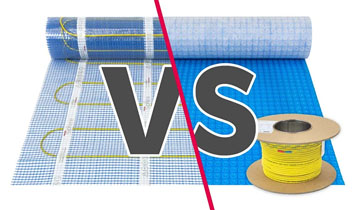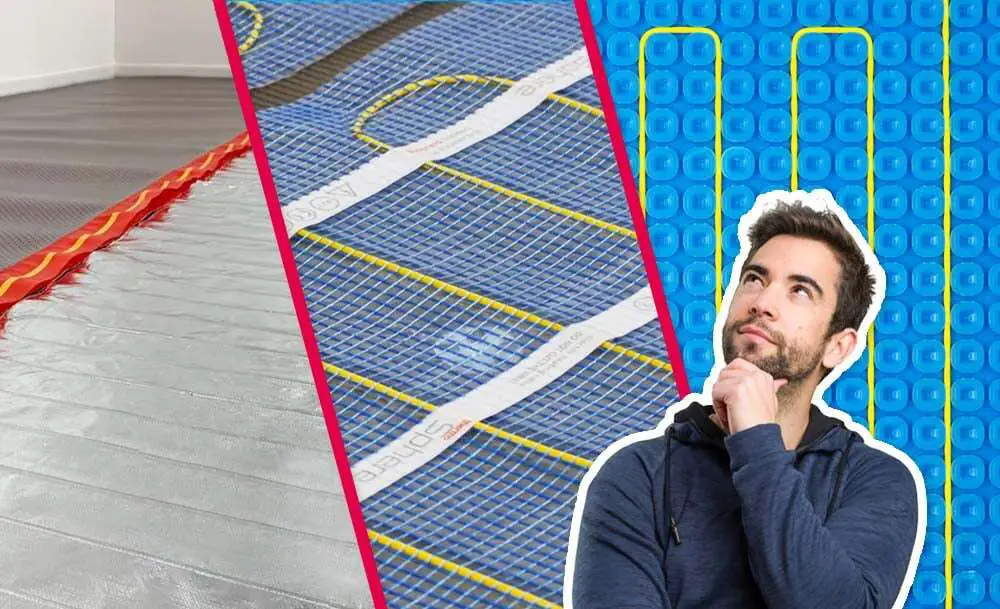8 min read
7 tips before buying electric underfloor heating
If you are in the market for an electric underfloor heating system for your next home renovation, then you have landed in the perfect place. We’ve...
7 min read
 Chris Hedges
:
Jan 12, 2023
Chris Hedges
:
Jan 12, 2023

In the UK we are becoming increasingly conscious of the rising cost of energy and the impact that heating our homes has on the environment. Electric heating offers an efficient and eco-friendly alternative to heating our homes than traditional gas central heating and it’s one of the factors that is helping the popularity of electric to continue to grow.
As you can imagine, the more popular electric heating has become, the more questions we get asked. So, we thought it would be a good idea to give you our answers to the ten most common electric underfloor heating questions we have been asked in the last 12 months.
If you have a question that hasn’t been covered in this blog, please either drop it in the comments below or contact one of the ThermoSphere team and we’ll have it answered in a jiffy!
This is, and for the foreseeable future will be, the elephant in the room.
There is no denying it, the cost per kilowatt hour (kWh) of gas (15p) is cheaper than electricity (52p). This does not take into consideration any regional variance of tariffs or the Energy Price Guarantee.
So, if your electric underfloor heating system is, as an example (and for easier maths), 200W per square metre, it will cost you 52p for every 5 metres of floor when you have the system on.
However, you’ll find that electric underfloor heating is only on for between 2-4 hours per day and more commonly found in bathrooms of averaging 2.5m2 in size. According to Which? ‘based on manufacturers and Beama estimates, we estimate that running underfloor heating for four hours a day in a 2.5m2 bathroom would incur monthly electricity costs of around £4-6’.
Running cost will also be heavily influenced by other factors which include:
In a nutshell, yes it can!
What do we mean by ‘main source of heat’? This is also known as ‘primary heat source’ and is a heating system used for most of the heating demand of your home.
If you are considering using electric underfloor heating as a primary heat source, we would recommend getting a heat loss calculation for your property. This will let you know the heating output of the system required to effectively heat the space.
Electric underfloor heating uses a large amount of current and therefore we would advise consulting your local electrician to check that the total load of the system does not exceed the total load of your electrical circuit.
Electric underfloor heating is 100% efficient at point of use.
What does this mean?
Every joule of energy you pay for is used at the exact point where the heat it is needed. Electric underfloor heating also operates at a much lower temperatures compared to traditional central heating because it effectively turns a large surface area (the floor) into one big radiator. This results is a system that uses between 15% – 40% less energy than a traditional radiator.
Another big plus for the efficiency conscious and environmentally aware homeowner is electric heating produces much less carbon emissions compared with gas alternatives. However, it’s important to note that to make an electric heating system totally emission-free, the electricity used to power it must be 100% from renewable sources such as wind or solar.
When deciding on what electric underfloor heating system to install, it will depend on what floor finish you plan to lay over it, the type of application such as a wet room and how well insulated the room is.
We’ll run through the floor finishes and guide you through what system is best. However, our team are on hand to help you select the right one. Simply give them a call to discuss your project.
Tile or stone floor finishes
If your plan is to choose tile or stone for your floor finish, we would recommend a heating and decoupling system (ThermoSphere Membrane) or a pre-spaced mesh mat system (ThermoSphere Mesh).
A heating and decupling system is a more recent innovation compared to a pre-spaced mesh mat system. The decoupling membrane is designed to prevent cracking, lifting and delamination of tiled floors. It acts like a decoupling layer which allows the tiled surface to move independently from the substrate. This type of system is also more commonly found in wet rooms because of its waterproofing properties.
Another benefit of this type of system is that they allow for different heating outputs by changing the spacing of the heating cable. For example, using wider spacing means that you can create a lower heat output which is ideal for well-insulated rooms.
The pre-spaced mesh mat system has a heating cable already attached to a mesh mat at regular intervals. You’ll find that there are a variety of outputs available. The higher the wattage, the faster the heat-up time. For example, 200W/m2 is perfect for high demand rooms like conservatories. 150W/m2 is a great primary heat source for well insulated rooms and 100W/m2 is usually for floor warming only.
For a more in-depth guide on electric underfloor heating for tile and stone floor finishes, read ‘The best electric underfloor heating for tile and stone floors’.
Wood, Carpet or Vinyl floors
If you plan to have a floating floor finish such as wood, carpet or vinyl then a foil electric underfloor heating system is the perfect fit. They usually have a specific output such as 140W/m2 (ThermoSphere Foil) which is designed to not overheat soft floor finishes and can be installed without adhesives.
These systems provide great thermal conductivity and fast heat up times because the heating cable is wrapped by two layers of foil which is an ideal thermal conductor.
If you plan to lay carpet, read ‘Can you use electric underfloor heating under carpet?’ which has some top tips you need to consider before installing electric underfloor heating. Plus we have the popular ‘What’s the best underfloor heating for living rooms and lounges?’ blog which also covers vinyl and wood floor finishes.
Any floor finish
You’ll find that In-screed electric underfloor heating systems are more readily used in new build or extension projects because the heating cable can easily be installed in the screed layer in the building phase and can be used with any floor finish. This type of system is ideal for rooms that are in almost constant use as they have longer heat up and cool down times.
The heating output per m2 can be adjusted by varying the cable spacing and if you plan to use it as a primary heat source, we recommend using it off peak to ensure greater energy efficiency.
In-screed electric heating systems will take longer to install compared with electric underfloor heating mats.
Often the first thing to be removed from an electric underfloor heating quote is insulation board which often leads to unhappy homeowners asking the question ‘why is my underfloor heating taking so long to heat the room?’. Without insulation board, your living space will take longer to reach your desired temperature and that means it will cost you more money to run and you’ll be wasting unnecessary energy.
By including insulation board, you will reduce heat being lost downwards through the subfloor Instead, most of the heat will be heating the floor above and improve the efficiency of your electric underfloor heating system by up to 50%!
Additional benefits include:
Still not convinced? Read our guide to insulation board.
There are so many different types of thermostats to choose from and it boils down to what type suits your lifestyle more than others. From a manual thermostat where you simply turn a dial to adjust the temperature to changing the temperature using your voice with a smart thermostat.
Manual thermostat: Ideal if you want something simple
If technology isn’t your thing and you only want to control the heating in a room infrequently, then the Manual thermostat is for you. Just remember that it isn’t Lot 20 compliant.
Programmable thermostat: The most common type of thermostat
If you are eager to reduce your energy consumption, and make a positive dent to your heating bills, then the Programmable thermostat fits perfectly. It’s EcoDesign Lot 20 compliant so it is jam packed full of energy saving features that you will enjoy.
Smart thermostat: Perfect for controlling your heating from your phone
Do you love your gadgets and gizmos? Are you already embracing smart home technology in your home? If so, a smart thermostat such as our SmartHome is your go to thermostat. It will monitor your energy consumption via the App and you’ll have complete peace of mind knowing you can control your heating via your smart phone and voice.
Smart thermostats have the most potential of any thermostat to help you to reduce your running cost of your electric underfloor heating system.
Dual Control: Conveniently control two heating appliances with one thermostat
If you want to easily control the heating in your bathroom and surround yourself with a luxury spa feeling, then the Dual Control thermostat has everything you need to control your electric underfloor heating and towel rail in one.
Nest or Hive thermostats
These thermostats are not suited to controlling electric underfloor heating.
You can find out why and more detail about choosing the right thermostat for you in the blog ‘What is the best thermostat to use for underfloor heating?’
Any ThermoSphere electric underfloor heating system is easy to install and any competent person or skilled DIYer can do it. However, the final connection of the system to the mains supply must be completed by a Part P registered electrician. This is to ensure safety and compliance.
You can buy electric underfloor heating directly online or in the majority of electrical wholesalers, merchants, bathroom shops and tile shops.
You can buy any ThermoSphere electric heating products from a wide network of resellers throughout the UK, and you can find your local ThermoSphere reseller using this handy search tool.
We just don’t sell direct. Sorry. But if you want to know the reason, we wrote a blog on it called ‘Where can I buy ThermoSphere electric heating? Can I buy from you?’.
Warranties on electric underfloor heating systems vary depending on what brand you decide to run with. When comparing warranties, we recommend checking the small print where possible.
If you feel that a ThermoSphere electric underfloor system is right for you, then you’ll be pleased to know that they all come with a comprehensive lifetime warranty. Unlike others, the warranty stays with the property and not the person. So, if you move, the electric underfloor heating system will be covered for your buyer too! To take advantage of the lifetime warranty, you must register your ThermoSphere electric underfloor heating installation.
You’ll be hard pushed to find a thermostat that comes with the same lifetime warranty as the underfloor heating system. On average, they come with a 3-year warranty and some brands give you the option to extend the warranty for your peace of mind.
Yes! Electric underfloor heating systems can be repaired.
When it comes to a damaged heating cable, it can be easily located and repaired by an electric underfloor heating repair specialist such as UFH Services Ltd. They can locate the damaged area using a thermal camera, lift the floor covering and repair the cable.
The cost of an electric underfloor heating repair depends on a few things. The cost ranges from between £300 to £500 depending on where you are in the UK, the type of repair needed, and the time taken to do it. This price does not usually include the cost of the replacement tile or floor finish.
If the fault is found to be a manufacturing fault, then you should be covered by the manufacturer’s warranty. But, as always, check the details of the warranty and don’t forget to register your system!
For further detail on repairing electric underfloor heating, read our dedicated blog.
As mentioned at the start of this blog, if you have a question that hasn’t been covered, please either drop it in the comments below or contact one of the ThermoSphere team and we’ll answer it.

8 min read
If you are in the market for an electric underfloor heating system for your next home renovation, then you have landed in the perfect place. We’ve...

14 min read
Deciding what is the best electric heating system to use for your project can often be confusing especially when many of them can effectively heat...

14 min read
So, you’ve completed your research on electric underfloor heating and have decided that it’s the perfect fit for your project. But, with so much...